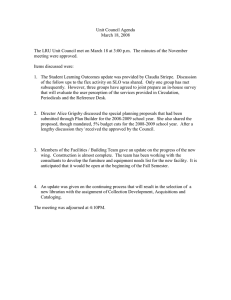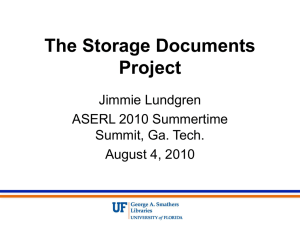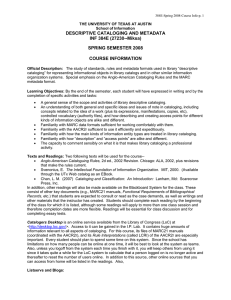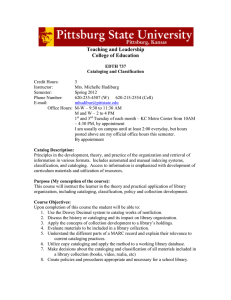Descriptive Cataloging and Metadata INF 384W
advertisement
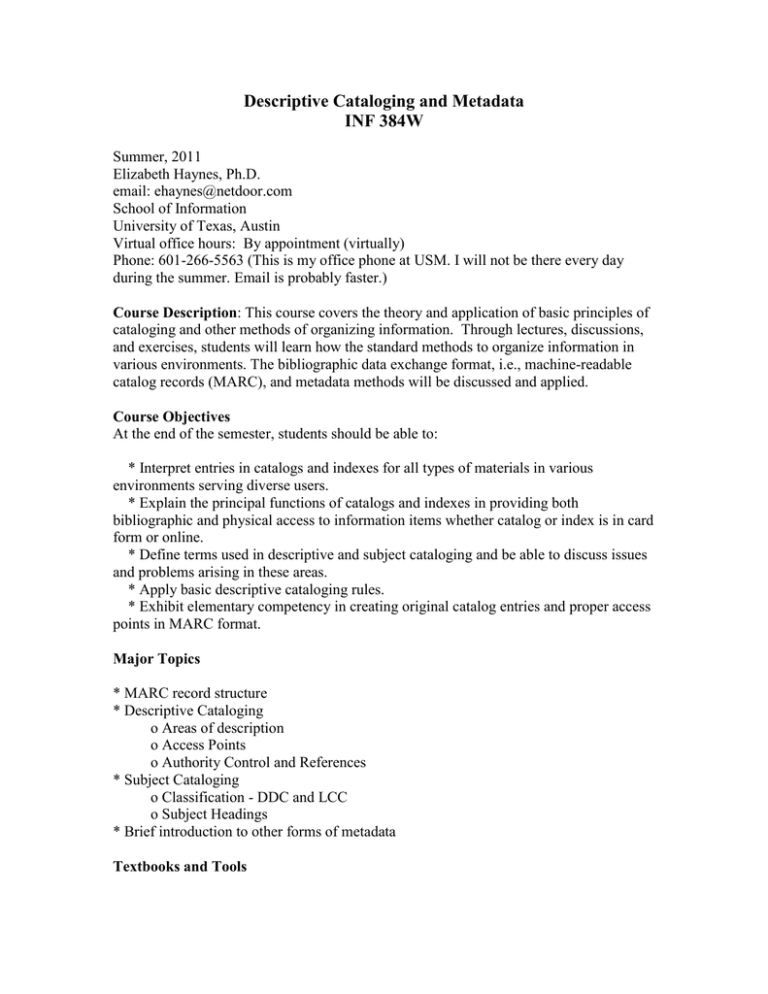
Descriptive Cataloging and Metadata INF 384W Summer, 2011 Elizabeth Haynes, Ph.D. email: ehaynes@netdoor.com School of Information University of Texas, Austin Virtual office hours: By appointment (virtually) Phone: 601-266-5563 (This is my office phone at USM. I will not be there every day during the summer. Email is probably faster.) Course Description: This course covers the theory and application of basic principles of cataloging and other methods of organizing information. Through lectures, discussions, and exercises, students will learn how the standard methods to organize information in various environments. The bibliographic data exchange format, i.e., machine-readable catalog records (MARC), and metadata methods will be discussed and applied. Course Objectives At the end of the semester, students should be able to: * Interpret entries in catalogs and indexes for all types of materials in various environments serving diverse users. * Explain the principal functions of catalogs and indexes in providing both bibliographic and physical access to information items whether catalog or index is in card form or online. * Define terms used in descriptive and subject cataloging and be able to discuss issues and problems arising in these areas. * Apply basic descriptive cataloging rules. * Exhibit elementary competency in creating original catalog entries and proper access points in MARC format. Major Topics * MARC record structure * Descriptive Cataloging o Areas of description o Access Points o Authority Control and References * Subject Cataloging o Classification - DDC and LCC o Subject Headings * Brief introduction to other forms of metadata Textbooks and Tools Chan, Lois Mai. Cataloging and Classification: An Introduction. 3rd ed. Scarecrow Press, 2007. 978-0-8108-6000-1 (pbk) Haynes, Elizabeth and Joanna Fountain. Unlocking the Mysteries of Cataloging. Libraries Unlimited, 2005. 1-59158-008-0 **Each student is required to e-mail the instructor at the beginning of the semester and to provide his/her e-mail address, mailing address, and ALL telephone numbers where the student can be reached. Method of Instruction: The course will be taught online. There will be several optional interactive discussions and opportunities to interact with the instructor. Interactive discussion times (Chats) - Wednesdays, 10:00 - 11:00; 6:30 - 7:30 pm (times are central daylight time). These chats are OPTIONAL -- attendance is not required. They will not be held every week but will be announced. If we need to have them at some other time in order for students to attend, we can work that out. Assignments 1. Students will read the assignments and posted notes as given on the course calendar. 2. Complete all assigned exercises (20%) 3. A paper of 1800 words (minimum) on a topic from a list to be provided by the instructor. Students should have a minimum of five sources and should use APA format. Papers should be double-spaced and should use 12-point font. Standard margins of 1-1/4 inches should be used. Additional information will be given (25%). 4. A midterm (25%) and a final will be given (30%). Exams are open-book take-home and will include both cataloging exercise questions and essay questions. Course Policies All assignments are due by the date indicated. Work not received on time will have to be graded as late. Late assignments will not be accepted more than 24 hours after due date without prior approval from the instructor and may be subject to grade reductions, at the instructor's discretion. All written assignments are to be submitted electronically through the course. Written assignment file names should begin with the student's last name and include the name of the assignment. Example: Haynes_MARCex1. Names must be on assignment -- just having your name in the file name is not enough. If you have trouble submitting an assignment electronically then email it to me as an attachment immediately and submit it electronically at your first opportunity. Grading Scale Points scale: 93-100 A 84-92 B 75-83 C 66-74 D Below 66 F Course Communication Communication between the professor and the students will be facilitated by way of email, interactive discussion room, and/or bulletin board. E-mail is used when private discussions are needed between the student and professor or between students. The discussion board will be an open format for all students at the same time. Group bulletin boards and interactive discussions may also be used. Revised May 17, 2011



